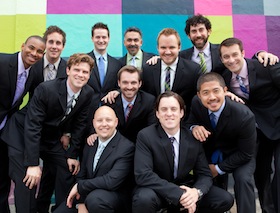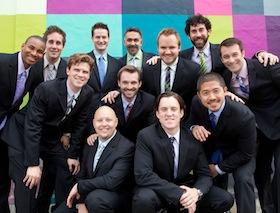
In Saturday’s concert at Mission Dolores Basilica (repeated in four other venues), the male vocal ensemble Chanticleer returned to a body of Baroque works from New Spain that it has exploring for several years, in association with Craig Russell, a professor at Cal Poly San Luis Obispo, who specializes in this music. It would be inaccurate to term this body of music from the early 18th-century “Mexican Baroque,” as Chanticleer has done (because Mexico did not gain independence until 1821, and because Spain’s colonies extended far beyond modern Mexico). The network of the church musical establishments extended into Peru, although Mexico City’s cathedral was a regional center (perhaps secondary to Morelia). Musically, the works of Antonio de Salazar (1650–1715) and Manuel de Sumaya (1680–1755) that Chanticleer performed Saturday are wholly dependent on Spanish and Italian forms, with elements of native color mostly negligible. While their works may have represented a missed opportunity at genre creation (and certainly at musical interest), they reflected the nature of colonialism: to convert and assimilate.
Related Article
Chanticleer's Mastery of Choral Literature
March 30, 2012
Chanticleer's Sweet Love Story
May 25, 2012
The concert’s balanced program of Marian (that is, having to do with the Virgin Mary) works came across as attractive and beautiful because the Baroque style is attractive and beautiful, especially when realized by such a polished choir as Chanticleer. The music of these composers is not exemplary of its Age, excelling more in craftsmanship than artistry, and the programming managed to weave the music together in such a way as to sustain far more interest than the music merits. This was especially true of works of the prima prattica— a 16th-century style of functional Catholic church music that coexisted alongside more modern forms well into the 19th century. Such throwaways as Salazar’s Aeterna Christi munera and Gloriosa virginum can be safely consigned back to museum storage. (My overactive musical imagination kept overlaying Frank Loesser’s much-abused song Heart and Soul on top of Salazar’s Conceptio glorioso, with its simpleton harmonic concept.)
The Baroque style is attractive and beautiful, especially when realized by such a polished choir as Chanticleer.
The exception to the rule was Salazar’s setting of Salve Regina, for double choir, which could hold its own against any setting of this famous text. While the work abounds in run-of-the-mill word painting (sighing music when Mary sighs, and the like), the antiphon’s success lies in its harmonic tension and paced formal concept. Chanticleer’s members, performing as usual without a conductor, were heavily emotive the entire evening, bobbing up and down in exuberation, and gazing out to the audience. It’s a formula that works for them, but I’d caution them to reserve the smiles for moments that really deserve them. Although Chanticleer is now running under interim artistic leadership, the ensemble sounds more vocally free and comfortable than it has in the past.
Must Be Lively, Must Be Prolific
The program incorporated additional lively villancicos, an Iberian genre of sacred works in the vernacular that would replace Latin works in cathedrals during important feasts. Eighteenth-century manuscripts of these exist by the thousands, usually set to anonymous texts by poets of modest ability. In Latin America, they were composed rapidly: The music director at Léon Cathedral in Nicaragua, to give just one example, had to compose 75 each year. The music is rather formulaic, although it has such charms as onomatopoetic “tirrarirarira” in Salazar’s Suenen clarines alegres (Sound the trumpets) and a vulgarly exuberant welcoming of the Virgin in his “Ola! Ola!”
The ensemble sounds more vocally free and comfortable than it has in the past.
Over time, these works adopted elements of Italian opera, and the concert included two full-scale Baroque arias, sung by countertenor Cortez Mitchell and tenor Ben Jones. Mitchell held his own in Sumaya’s Ya la naturaleza redimida with plucky aplomb. Hinman and violinist Lisa Grodin were more challenged by the same composer’s Alegres luces del dia, perhaps feeling fatigued by the challenge of moving between choral and solistic singing in the demanding Baroque style. The more choralistic call-and-response solos of the various villancicos were more successful, with such standouts as baritone Matthew Knickman and especially tenor Matthew Curtis.
The concert also wove in several excerpts of plainchant. With the inclusion of a small quartet of period instruments and a reference to historicism in the creation of performing editions and the like, I wonder whether a reevaluation of performing practice of plainchant is in store. Chanticleer’s approach is one that emerged in 19th-century France, but scholars now believe that during the 17th and 18th centuries chant was more measured and was performed in long, harsh notes. This may contradict the refined Chanticleer sound, yet it could be worthy of exploration.

